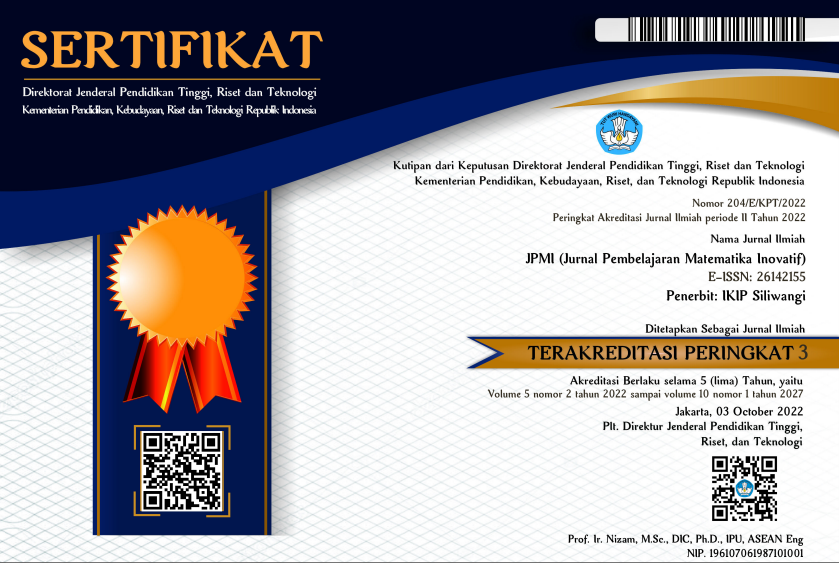Media Visual Basic for Application (VBA) Excel dalam meningkatkan kemampuan penalaran dan keaktifan belajar melalui penerapan model problem based learning
DOI:
https://doi.org/10.22460/jpmi.v7i4.23736Kata Kunci:
VBA Excel, Mathematical reasoning ability, Student learning activeness, Problem-based learningAbstrak
This research aims to find out and analyze the media visual basic for application (VBA) Excel in improving students' reasoning abilities and active learning through learning models problem-based learning. The research method and design used is a quasi-experimental design nonequivalent control group. The subjects in this research were class VIII students at one of the state junior high schools in the West Bandung Regency area. The data collection technique used in this research is data pretest, posttest, and N-Gain mathematical reasoning abilities and student learning activity questionnaires. Then the data is processed using software Microsoft Excel 2020 and IBM SPSS Statistics 26. The research results show that the application of VBA media Excel through learning models problem-based learning can improve students' mathematical reasoning abilities and active learning. One of the findings shows that students have the ability and skills to apply concepts or material through problems that exist in the student environment and are able to complete complex calculations, analyze data, or prepare solution processes through VBA Excel.
Referensi
Afifah, B. A., Imswatama, A., & Setiani, A. (2020). Penerapan model problem based learning untuk meningkatkan kemampuan penalaran matematis siswa. De Fermat : Jurnal Pendidikan Matematika, 3(1), 9–16. https://doi.org/10.36277/defermat.v3i1.46
Apriyantini, N. P. D., & Sukendra, I. K. (2023). Penerapan pembelajaran berdiferensiasi berbantuan e-lkpd untuk meningkatkan keaktifan belajar matematika siswa. Jurnal Pendidikan (Widyadari), 24(1), 55–63. https://doi.org/10.5281/zenodo.7813406
Baroody, A. J., & Coslick, R. T. (1993). Problem solving, reasoning, and communicating, K-8: helping children think mathematically. Merrill.
Bernard, M., & Chotimah, S. (2018). Improve student mathematical reasoning ability with open-ended approach using VBA for powerpoint. AIP Conference Proceedings, 2014(1). https://doi.org/10.1063/1.5054417
Bernard, M., & Senjayawati, E. (2019). Developing the students’ Ability in understanding mathematics and self-confidence with VBA for excel. JRAMathEdu (Journal of Research and Advances in Mathematics Education), 4(1), 45–56. https://doi.org/10.23917/jramathedu.v4i1.6349
Cahyati, W. N., Arian, H., Lestari, P. A., & Setyowati, K. D. (2023). Pentingnya penerapan teknologi dalam pembelajaran matematika di era digital. Prosiding Seminar Nasional Pendidikan FPMIPA, 1(1), 244–247. https://doi.org/https://prosiding.ikippgribojonegoro.ac.id/index.php/FPMIPA/article/view/2191
Dewi, P. M., & Ansori, Y. Z. (2023). Penerapan model problem based learning terhadap kemampuan penalaran matematis siswa. Jurnal Pendidikan Matematika, 2(1), 24–29. https://doi.org/https://doi.org/10.56916/jp.v2i1.293
Hendriana, H., Rohaeti, E. E., & Sumarmo, U. (2017). Hard skills dan soft skills matematik siswa. PT Refika Aditama.
Lestari, K. E., & Yudhanegara, O. R. (2015). Penelitian pendidikan matematika. PT Refika Aditama.
McCoog, I. J. (2008). 21st century teaching and learning. Online Submission. https://eric.ed.gov/?id=ED502607
Miristianti, C. N., Sofiatin, I., & Iqbal, M. (2024). Pengaruh penggunaan teknologi dalam pembelajaran di dunia pendidikan sekolah dasar. Insan Cendikia: Jurnal Pendidikan Dan Kebudayaan, 1(1), 34–40. https://doi.org/https://doi.org/10.56480/insancendekia.v1i1_996
Nababan, S. A. (2020). Analisis kemampuan penalaran matematis siswa MTs dalam menyelesaikan soal-soal geometri. Genta Mulia: Jurnal Ilmiah Pendidikan, 11(1), 6–12. https://doi.org/10.36312/jisip.v4i3.1239
NCTM. (1991). Research advisory committee report: NCTM standards research catalyst conference: research advisory committee of the national council of teachers of mathematics. Journal for Research in Mathematics Education JRME, 22(4), 293–296. https://doi.org/10.5951/jresematheduc.22.4.0293
Prasetyo, A. D., & Abduh, M. (2021). peningkatan keaktifan belajar siswa melalui model discovery learning di sekolah dasar. Jurnal Basicedu, 5(4), 1717–1724. https://doi.org/https://doi.org/10.31004/basicedu.v5i4.991
Rohaeti, E. E., Bernard, M., & Novtiar, C. (2019). Pengembangan media visual basic application untuk meningkatkan kemampuan penalaran siswa SMP dengan pendekatan open-ended. SJME (Supremum Journal of Mathematics Education), 3(2), 95–107. https://doi.org/10.35706/sjme.v3i2.1897
Ruqoyyah, S., Murni, S., & Linda, L. (2020). Kemampuan pemahaman konsep dan resiliensi matematika dengan VBA microsoft excel. Purwakarta: CV. Tre Alea Jacta Pedagogie.
Setyo, A. A., Fathurahman, Mu., & Anwar, Z. (2020). Strategi pembelajaran problem based learning. Yayasan Barcode.
Sugiyono, S. (2021). Metode Penelitian Pendidikan. Alfabeta Bandung.
Tamur, M., Weinhandl, R., Sennen, E., & Nurjaman, A. (2022). The effect of think-pair-share cooperative learning on students’ mathematical communication ability. JTAM (Jurnal Teori Dan Aplikasi Matematika0, 6(4), 1027–1033. https://doi.org/10.1063/5.0102565
Unduhan
Diterbitkan
Terbitan
Bagian
Lisensi

Artikel ini berlisensiCreative Commons Attribution-ShareAlike 4.0 International License.
The author is responsible for acquiring the permission(s) to reproduce any copyrighted figures, tables, data, or text that are being used in the submitted paper. Authors should note that text quotations of more than 250 words from a published or copyrighted work will require grant of permission from the original publisher to reprint. The written permission letter(s) must be submitted together with the manuscript.
















